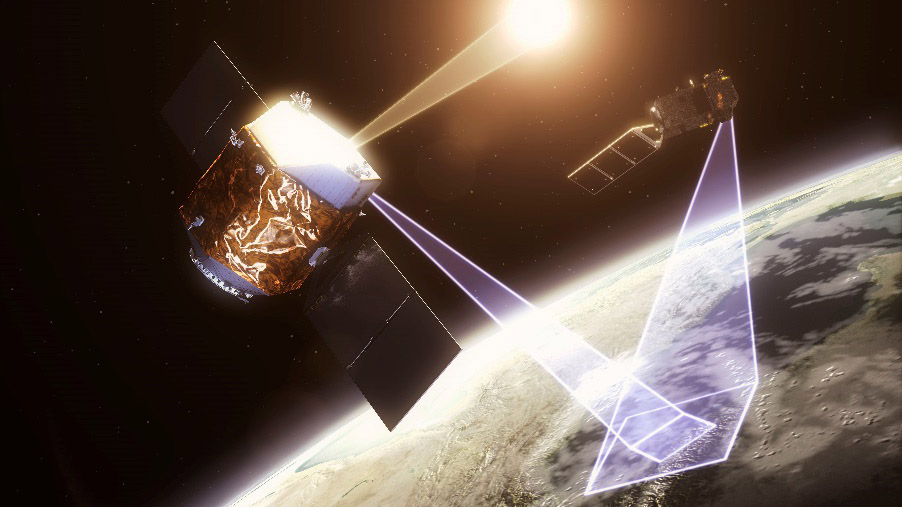Europe announces new satellite constellation to track human-made greenhouse gas emissions
Monitoring greenhouse gas emissions from space will help keep the world on track to meet climate change mitigation targets.

A new space mission will track human-made emissions of greenhouse gases from space to help keep the world on track to meet climate change mitigation targets.
The new mission, announced by the European Space Agency (ESA) and the European Union's Earth-monitoring program Copernicus during the U.N Climate Change Conference COP26 in Glasgow on Tuesday (Nov 2), will rely on a dedicated constellation of satellites.
The constellation, called European CO2 Monitoring and Verification Support Capacity (CO2MVS) on anthropogenic emissions, is currently being developed by ESA and the European Organisation for the Exploitation of Meteorological Satellites (EUMETSAT). Once in orbit, the satellites will measure concentrations of the two most common greenhouse gases, carbon dioxide and methane, in unprecedented detail and in near real time, Copernicus program representatives said in a statement.
Carbon dioxide, which is released during fossil fuel combustion and in agriculture, is the most common climate-warming gas, accounting for nearly 80% of all greenhouse gas emissions. Methane, while accounting only for about 16% of global greenhouse gas emissions, is 80 times more potent in warming up Earth's atmosphere than carbon dioxide and therefore also a cause for concern.
Related: Could climate change make humans go extinct?
According to Copernicus representatives, the new CO2MVS constellation should be up and running by 2026, in time to help the world review its progress in curbing greenhouse gas emissions as required by the Paris Agreement, the international treaty negotiated during the 2015 U.N. Climate Change Conference held in the French capital. That agreement requires nations to take stock of their progress every five years to ensure that countries are on track to meet their greenhouse gas reduction targets. The first such analysis is expected to conclude by 2023; the new constellations could be part of the second, due to be completed in 2028.
Copernicus representatives said in the statement that the new satellite tool will be "game-changing," allowing climate researchers to see individual sources of greenhouse gas emissions such as power plants and fossil fuel production sites.
Get the Space.com Newsletter
Breaking space news, the latest updates on rocket launches, skywatching events and more!
Satellites currently measure changes in atmospheric concentrations of carbon dioxide; however, these are mainly related to natural variations in the carbon cycle, Copernicus officials wrote in the statement, and cannot spot individual industrial sources.
Canadian company GHGSat is currently using three microsatellites to detect sources of methane emissions. The project, which launched its first satellite in 2016, has successfully measured methane leaks from mining operations and offshore oil platforms as well as waste disposal sites.
But the new European constellation is designed to provide broader coverage, sharper detail and higher accuracy compared to what's currently available, Copernicus representatives said in the press release.
The data will be integrated into computer models of Earth's atmosphere and biosphere that are already being used by the Copernicus Atmosphere Monitoring Service (CAMS).
The European CO2 Monitoring and Verification Support Capacity (CO2MVS) on anthropogenic emissions, will be administered by the European Centre for Medium-Range Weather Forecasts (ECMWF) on behalf of the European Commission with funding from the EU.
"Since the start of the industrial revolution, we have seen carbon dioxide levels increase faster than ever before, and there is an increasing urgency to take real steps to make very significant emission reductions," Richard Engelen, deputy director of CAMS, said in the statement. "By providing globally consistent and high-quality data on anthropogenic emissions we can support policymakers with this enormous challenge."
Follow Tereza Pultarova on Twitter @TerezaPultarova. Follow us on Twitter @Spacedotcom and on Facebook.
Join our Space Forums to keep talking space on the latest missions, night sky and more! And if you have a news tip, correction or comment, let us know at: community@space.com.

Tereza is a London-based science and technology journalist, aspiring fiction writer and amateur gymnast. Originally from Prague, the Czech Republic, she spent the first seven years of her career working as a reporter, script-writer and presenter for various TV programmes of the Czech Public Service Television. She later took a career break to pursue further education and added a Master's in Science from the International Space University, France, to her Bachelor's in Journalism and Master's in Cultural Anthropology from Prague's Charles University. She worked as a reporter at the Engineering and Technology magazine, freelanced for a range of publications including Live Science, Space.com, Professional Engineering, Via Satellite and Space News and served as a maternity cover science editor at the European Space Agency.









